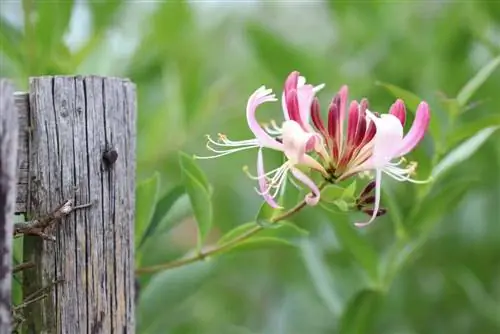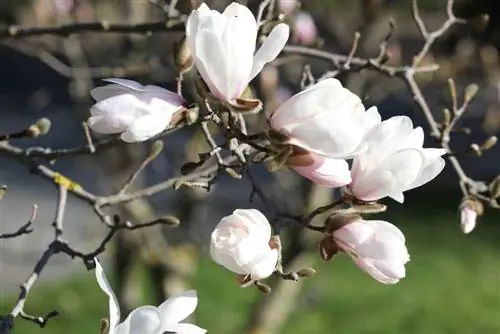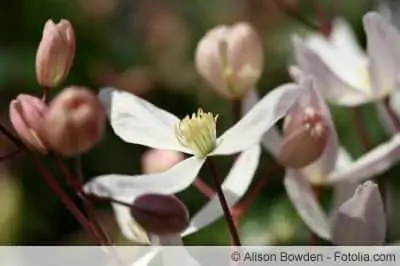- Author admin [email protected].
- Public 2023-12-17 03:39.
- Last modified 2025-01-24 12:45.
Honeysuckles are poisonous and the creeper is originally native to North America and North Africa. Although it comes from warmer regions, evergreen honeysuckle survives the winter without any problems. If the plant is well cared for, it can grow to be several meters high. Therefore, the most important thing is to choose a suitable location, otherwise there can be problems with lush growth.
Location
The garden honeysuckle has no special requirements for the location. It grows very well in both shade and sun. However, numerous flowers also form, mainly in sunny locations. Otherwise, the creeper is a decorative greenery. A location with high humidity is ideal, which is why partially shaded places are also suitable and some protection from wind. Although the garden honeysuckle is a climbing plant, it has little ability to hold itself on with tendrils. It just loops around objects. Therefore, a location is required where these requirements are met. That's why climbing aids are a prerequisite for the plants.
Note:
When growing in a pot, a trellis is also required.
Substrate
Although garden honeysuckle is very undemanding when it comes to soil, good conditions help the plants develop beautifully. The soil should be constantly moist, but no waterlogging should occur. This can lead to root rot and plant death within a short period of time. The ideal substrate for garden honeysuckle is:
- easy
- air permeable
- humus-rich
- calcareous
When growing in a pot, there should be an additional drainage layer in the soil to prevent waterlogging.
Planting
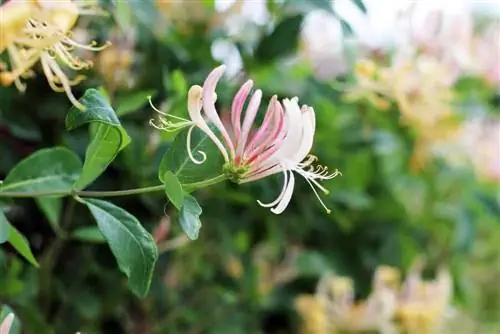
When planting garden biting leaf, it is important to think about the ground cover. These ensure that the soil does not dry out too quickly. Plants such as different types of nettles or evergreens are suitable as ground cover. As an alternative to living ground cover, a layer of bark mulch can also be applied.
Planting is done as follows:
- Dig a planting hole twice the size of the root ball
- If necessary, fill in a drainage layer made of coarse stone
- Prepare mixture of compost and sand
- loosen root ball
- Position the plant in the middle of the planting hole
- Cover the plant with a soil-sand mixture
- if necessary, attach supports
- Plant ground cover or apply a layer of mulch
If the root ball is in a jute cloth, it does not necessarily have to be removed. It usually rots over the next few years and the roots can grow through without any problems. However, the jute cloth should at least be folded back or cut open at the top.
Pouring
An evergreen garden honeysuckle rarely needs to be watered when planted outdoors. This is only necessary if there are longer dry periods. In winter, care should also be taken to ensure that the substrate remains constantly moist. If this is not possible due to persistent frost, the honeysuckle may drop its leaves. This doesn't look nice, but it is purely self-protection and as soon as the water supply is available, the plant will sprout again.
When growing in pots, the substrate must be checked regularly. In this case, you should also pay attention to signs of a lack of water, such as curled leaves. Sufficient watering quickly solves the problem, but no waterlogging should occur.
Fertilize
In order for the creeper to develop well, it needs a lot of nutrients. Compost is worked into the soil in spring and autumn. In addition, the plant is supplied with liquid fertilizer for perennials every two to three weeks.
Trails
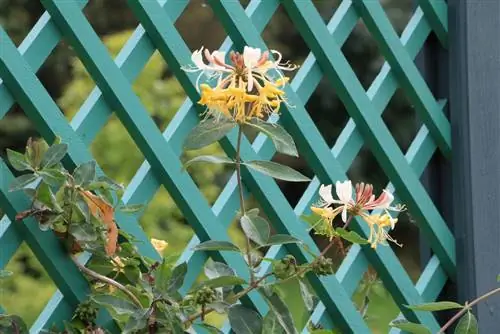
Suitable climbing aids are essential for the garden honeysuckle. These promote the formation of a dense leaf wall and prevent baldness in the lower area. The honeysuckle accepts different climbing aids such as:
- Grid
- Nets
- Staves
It is important that the climbing aid has branches where the plant can hold on. In this way, the shoots can also be directed in a certain direction. If you are creative, you can direct the garden honeysuckle into the form of fans or other shapes. The climbing aid does not have to be visually attractive, because the aim is for it to be completely hidden by the garden honeysuckle. Waste wood such as unused slats can also be used for this, as the plant will overgrow it within a short time in good conditions.
Cut
There are several reasons why it is necessary to cut garden honeysuckle:
- Barberness
- growth too dense
- Height Restriction
The ideal time for pruning is spring. Usually only thinning cuts are necessary to encourage branching. Strong tendrils are retained, which provide stability. If there is baldness, you can easily cut back heavily. If you cut into old wood, this encourages the formation of new shoots in the lower area. Since honeysuckle is poisonous, gloves should always be worn when cutting. However, the cuttings can be disposed of in the compost and not stored separately.
Propagation by cuttings
When pruning in spring, cuttings can also be put aside to propagate the honeysuckle. The cuttings should already be somewhat woody. Two-year-old shoots that are not too old but not too soft are ideal. The lower leaves are removed and the cutting must be planted at least three eyes deep. A mixture of sand and compost is ideal as a substrate.
In the first few weeks, care must be taken to ensure that the substrate always remains moist. A plastic cover helps here, as it also prevents too much moisture from being released through the leaves. However, the cover must also be removed occasionally for ventilation, otherwise mold can form. New leaves usually form within a few weeks and this is also a sure sign that roots have formed. However, you should wait until autumn at the latest before the cuttings are transplanted.
Propagation by reducers
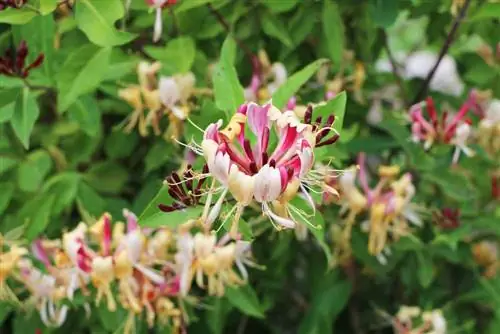
As an alternative to propagation via cuttings, planters can also be made. More rarely, garden honeysuckle is also propagated from seeds, but this is very time-consuming, which is why propagation via cuttings or planters is preferred. When propagating using lowering plants, proceed as follows:
- choose a suitable two-year-old vine
- Remove leaves and side shoots
- leave three to five leaves on the shoot tip
- Dig a 10 cm deep trench
- Incorporate compost
- Place the shoot in the recess
- Fix the shoot with a bent wire
- Righten the shoot tip vertically and fix it to a stick
- Fill the trench with a soil-sand mixture.
Diseases and pests
Honeysuckle is not susceptible to diseases, but is susceptible to some pests. Aphids in particular can affect the plant. Therefore, the garden honeysuckle should be checked regularly for aphid infestation. The lice particularly prefer young shoots and flowers. If there is an infestation, the first step should be to check whether the soil is too dry. Lice prefer dry soil and do not like to move over moist substrate. The lice themselves can be combated with home remedies. A solution of soft soap and water is ideal. This does not harm the plant, but usually drives away the lice very well.
Note:
If there is a lice infestation, not only the garden honeysuckle should be checked, but also the surrounding plants.
Wintering
In winter, garden honeysuckle does not require any special care. It does not require additional protection as it is hardy. Only the substrate should be checked on frost-free stretches to see whether it is still moist enough. If necessary, watering should be carried out after a long period of frost. However, when growing in a pot, care must be taken to ensure that the root ball is not damaged. Therefore, the pot of garden honeysuckle must be hammered in in the fall. For example, bags or insulation made of bubble wrap are suitable for this. The pot is placed on a wooden or Styrofoam plate, which also protects it from below.
When grown in a pot, the plant can also be overwintered in a cool and bright cellar. Watering is done sparingly during this time - fertilization is not necessary until next spring. However, the honeysuckle should be checked regularly for pest infestation in its winter quarters. Pruning in autumn is not necessary if it is kept indoors over the winter. The plant is not cut again until spring.

